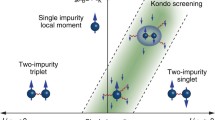Abstract
A framework for studying impurity scattering in dilute, non-magnetic, metal alloys can be developed from a knowledge of the exact electronic eigenstates of a single impurity in an otherwise perfect lattice of muffin tin potentials. Such an approach has been developed for systems in which the impurity occupies a substitutional site of the lattice, as will be discussed by Coleridge, Lee, Harris, and other speakers of this conference. In this paper, motivated by recent experimental studies of Dingle temperature anisotropies induced by hydrogen impurities in copper, we will discuss the analogous treatment of scattering by interstitial impurities. In contrast to a substitutional impurity, an interstitial impurity introduces an additional scattering site into the lattice. Whereas the substitutional impurity wavefunctions can be described in terms of the same structure factors as can the Bloch wavefunctions for the pure host lattice, the interstitial impurity wavefunctions depend upon additional structure factors appropriate to the new scattering geometry. These additional structure factors appear in the transition matrix for impurity-induced scattering between Bloch states of the host lattice, and consequently in the weight factors involved in a partial wave analysis of the Dingle temperature anisotropies.
Similar content being viewed by others
References
Lengeler, B., Wampler, W. R.: 13th International Low Temperature Physics Conference (LT 13), Boulder, Colo. Aug. 1972. Vol. 4, pg. 173, Plenum, N.Y. (1974), Dye, D., Lowndes, D. H., Lengeler, B.: Phys. Status Solidi (b)60, 399 (1973)
Dupree, T. H.: Ann. Phys.15, 63 (1961)
Morgan, G. J.: Proc. Phys. Soc.89, 365 (1966)
Beeby, J. L.: Proc. Roy. Soc.302, 113 (1967)
Harris, R.: J. Phys. C.3, 172 (1970); J. Phys. F.3, 89 (1973)
Blaker, J. W., Harris, R.: J. Phys. C4, 569 (1971)
Coleridge, P. T., Lee, M. J. G.: Phys. Rev. Letters31 997 (1973)
Coleridge, P. T., Holzwarth, N. A. W., Lee, M. J. G.: Phys. Rev. B10, 1213 (1974)
Lee, M. J. G., Coleridge, P. T., Holzwarth, N. A. W.: manuscript in preparation
Holzwarth, N. A. W.: Phys. Rev. B10, 3718 (1975)
Kohn, W., Rostoker, N.: Phys. Rev.94, 1111 (1954)
Springford, M.: Advances in Phys.20, 493 (1971)
The values ofW Γ ll (εF) listed here for the substitutional geometry agree with those published by Coleridgeet al. (Ref. 6) within about 3%. In the present work thel=3 host phase shifts were contrained to be zero; thel≤2 host phase shifts were obtained as the best 3-parameter fit to Fermi surface data. The resultant host phase shifts listed in Table 3 differ slightly from those used by Coleridgeet al., in which case a smalll=3 phase shift was introduced to slightly improve the Fermi surface fit.
[ξ−χ Γ]−1 for the substitutional geometry is directly proportional to the scattering parametersS Γ ll defined by Coleridge and Lee [6].
Morse, P. M.: Proc. National Acad. Sci.42, 276 (1956)
Ham, F. S., Segall, B.: Phys. Rev.124, 1786 (1961)
Ewald, P. P.: Ann. Phys. (Leipzig)49, 1 (1916)
Lowndes, D. H., Miller, K. M., Poulsen, P. G., Springford, M.: Proc. Roy. Soc. (London) A331, 497 (1973)
Author information
Authors and Affiliations
Additional information
This work was supported by the National Science Foundation through the Materials Research Laboratory at the University of Chicago.
Rights and permissions
About this article
Cite this article
Holzwarth, N.A.W., Lee, M.J.G. Theory of impurity scattering: Interstitial impurities. Phys cond Matter 19, 161–170 (1975). https://doi.org/10.1007/BF01458861
Issue Date:
DOI: https://doi.org/10.1007/BF01458861




